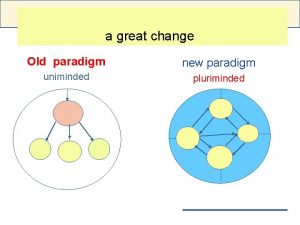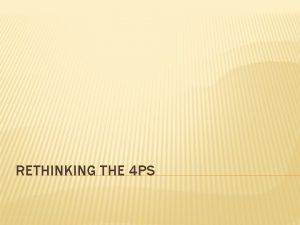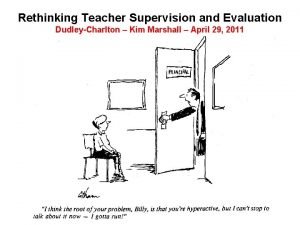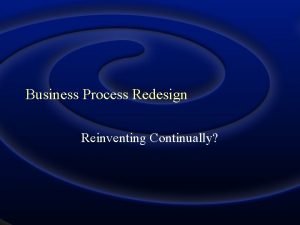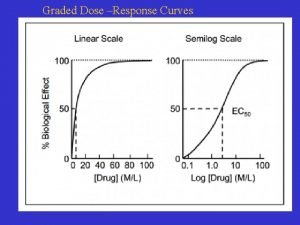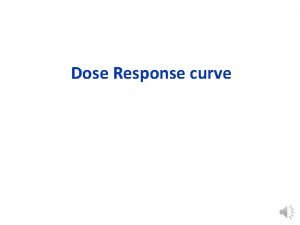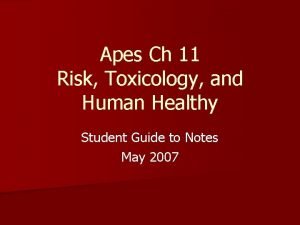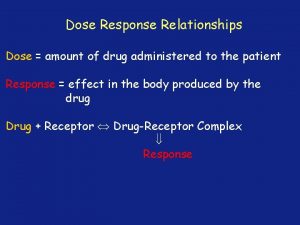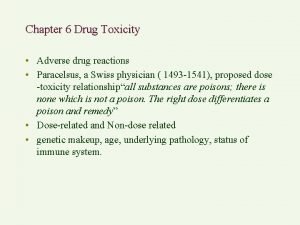Rethinking the Dose Response Paradigm Why Paracelsus Was

















- Slides: 17

Rethinking the Dose Response Paradigm Why Paracelsus Was Wrong, Poe Was Right, Most Exposure Studies Are Flawed, and You Can’t Party Like You Used To ! Albert Donnay, MHS UMB Toxicology Seminar 1 February 2006 (c)2006 Albert Donnay

Assumptions, Assumptions ASSUME you used to Party more when you were younger (does not apply to those who are still young!). u ASSUME that now, even if you really try, you cannot party as hard as you used to without experiencing adverse symptoms. So what aspects of hard partying can old people no longer tolerate? u staying up late… u listening to loud music… u dancing and/or just hanging out for hours with boisterous crowds … u ingesting large quantities of alcohol and/or other drugs… u smoking or at least being around people who are smoking… u all of the above, especially in combination… u Any exceptions in this room? Do you know any adult exceptions? ( There are exceptions– but why them and not us? ) (c)2006 Albert Donnay

According to the Dose Response Paradigm of Aureolus Theophrastus Bombastus von Hohenheim Paracelsus u u In any animal or human, exposure to any substance at some sufficiently high dose will produce symptoms, and moreso with increasing dose, but not below this dose. This is the fundamental assumption underlying all regulation (and litigation) of toxic exposures in (c)2006 Albert Donnay

Why Paracelsus Was Wrong Well Recognized Non-Controversial Exceptions: u At the high end of exposure, clear that for some toxins, increasing dose beyond some level does not increase symptoms, aka the threshold effect or habituation u At the low end, clear that those with allergies experience symptoms at much lower doses (even trace exposures) compared to those without allergies, aka the atopic response Controversial exceptions: u Clear but not well understood why some dose response curves are NOT LINEAR, but U-shaped, aka the hormetic response u Also not well understood why some individuals develop non-allergic sensitization to very low levels of chemical(s) and other stressors that were previously well tolerated, aka the “I can’t party like I used to” effect, or MUSES Syndrome (c)2006 Albert Donnay

Not just a partying problem… u u u Low-level sensitization following high-level habituation contributes to the difficulty of breaking drug, alcohol and tobacco addiction. “Healthy” workers who develop a tolerance for occupational chemical exposures may become permanently sensitized to them following long absences (from injury, illness, vacation or layoff). Children and adults who experience chronic or repeated high level exposures to toxins in their homes such as mold or pesticides may later become hypersensitized to low--and previously tolerated-levels other petrochemicals People who try to resume taking a medication that they took—and then stopped taking--long ago may experience new and/or more severe side effects. Temporary sensitization to low-levels of chemical exposures such as fragrances is a common feature of many transient conditions, such as migraines, asthma attacks and PMS. (c)2006 Albert Donnay

And not just a chemical exposure problem… Humans can develop asymptomatic habituation or tolerance to high levels of all kinds of stressors; But if they lose their habituation via withdrawal, they may then also become hypersensitive to very low levels of the same stressors (via modulation of nerve action firing potentials by endogenous CO) u High Altitude (consider local resident vs. Kansas tourist) u Loud Noise (consider rock musician vs. librarian) u High Heat (consider migrant farm worker vs. office worker) u Bright Light (consider Inuit vs. coal miner) u Pollen & Dander (consider child raised on farm vs. suburban home) u ETS (consider smoker vs. non-smoker vs. ex-smoker) u Trauma (consider tolerance of deployed soldier in war vs. retired) u Temporary Multi-Sensory Sensitivity is associated with some transient conditions (migraine and PMS again) but may persist for years after untreated chronic carbon monoxide poisoning (c)2006 Albert Donnay

Endogenous CO Pathways Induced by Physical, Chemical, Biological and/or Mental Stress Above : Carbon Monoxide, CRC Press, 1996, p 71 Carbon Monoxide Toxicity, CRC Press, 2000, p 22 (c)2006 Albert Donnay

A problem with most toxic exposure studies u u u Outside of allergy and addiction research, few human or animal studies are designed to assess their subjects’ their degree of sensitization or habituation Human exposure studies considered by those establishing Occupational Exposure Limits (TLVs) do not usually include retired and thus potentially sensitized workers, but instead focus on tolerances of those still working, who are most likely to have the highest tolerances. Most animal exposure use identically raised animals with no prior exposure experience which are then exposed to high levels according to a frequent dosing schedule. This is an excellent design to induce habituation, but animal studies are rarely designed to also assess sensitization by keeping a cohort alive longer through a long withdrawal period followed by re-exposure at a much lower level. (c)2006 Albert Donnay

(c)2006 Albert Donnay

But Edgar Allan Poe (1809 -1849) first recognized the essence of sensitization Poe changed from having a high tolerance for alcohol and partying in his college years to low tolerance later in life: “My sensitive temperament could not stand an excitement which was an everyday matter to my companions. . For some days after each excess I was invariably confined to bed. ” EAP, letter to Dr. Joseph Snodgrass, 8/1/1841 u Poe became hypersensitive not just to alcohol but to all types of sensory stimuli (aka, Multi-Sensory Sensitivity): ““True!—nervous—very, very dreadfully nervous I had been and am; but why will you say that I am mad? The disease had sharpened my senses—not destroyed, not dulled them. … Have I not told you that what you mistake for madness is but overacuteness of the senses? ” EAP, The Tell Tale Heart, 1843 u (c)2006 Albert Donnay

Poe’s Most Explicit Description of Sensitization is in Fall of the House of Usher (1839) u u u “[Roderick Usher] suffered much from a morbid acuteness of the senses: insipid food was alone endurable; he could wear only garments of certain texture; the odors of all flowers were oppressive; his eyes were tortured by even a faint light; and there were but peculiar sounds, and these from stringed instruments, which did not inspire him with horror” (c)2006 Albert Donnay

Conclusions Paracelsus’ Dose Response paradigm fails to account for exposure history and the potential for both: a) asymptomatic habituation to high levels of exposure from chronic or frequently repeated exposures; and b) hypersymptomatic sensitization to very low levels of exposure following extended withdrawal from such habituation u Individual dose response curves shift and change shape over time depending on both recent and long-term exposure history. u Animal and human studies that do not control for their subjects’ prior exposure history may be undermined by these differences. u Occupational and public exposure limits based on the experience of highly exposed (habituated) populations are not protective of de-habituated and sensitized populations u (c)2006 Albert Donnay

Dose Response Curve Depends on History u u u Any animal may have a positive, negative or neutral nonresponse to any given dose of any toxin at any time depending on the habituating vs. sensitizing nature of the magnitude, frequency, duration and route of all their prior exposures These parameters are studied in exposure assessment models but not integrated into exposure standards based on dose response models that focus on time weighted averages or total cumulative doses. Toxicological studies need to assess different exposure patterns: naïve (no prior exposure), habituated (aka addiction), and sensitized (post addiction). (c)2006 Albert Donnay

More Conclusions Poe was right: sensitization is not madness! u You can’t party like you used to because you no longer party as frequently as you used to, which has caused you to lose your tolerance for all the sensory stressors involved. u Good News! You may be able to party hard again but only if you resume partying hard again on a regular basis… OR u You could start smoking regularly, which will greatly increase your CO level and thus also your tolerance for the much lower levels of CO produced endogenously by HO-1, the universal stress enzyme, in response to all kinds of sensory stressors. u (c)2006 Albert Donnay

Pop Quiz u u u Given what you now know about the role of CO in sensitization, what results would you expect from a study of: Dark Adaptation of the Eye [and subsequent light sensitivity] during Carbon Monoxide Exposure in Smokers and Nonsmokers (von Restorff W and Hebisch S, Aviation, Space, and Environmental Medicine, 1988; 59(10): 928 -931) After exposing smokers and non-smokers to 5000 ppm CO for 5 minutes, the dark adaptation time increased 16% in both groups, but the subsequent light sensitivity of their dark adapted eyes was much more significantly reduced among the smokers (36 to 40%) than the non-smokers (7 to 17%). This shows that a) CO exposure impairs habituation time, even in smokers, and b) Smokers are less sensitive to light when exposed to more CO. (c)2006 Albert Donnay

Bonus Presentation: MCS Research at the Univ. of Toronto led by Gail Mc. Keown-Eyssen u u u Inspired by MCS Symposium at American Chemical Society in 1998 2000: Reproducibility of the University of Toronto self-administered questionnaire used to assess environmental sensitivity. Am J Epidemiol. 151(12): 1216 -22. 2001: MCS: discriminant validity of case definitions. Arch Environ Health. 56(5): 406 -12. 2004: Case-control study of genotypes in multiple chemical sensitivity: CYP 2 D 6, NAT 1, NAT 2, PON 1, PON 2 and MTHFR. Int J Epidemiol. 33(5): 971 -8. 2004: Case-control study of multiple chemical sensitivity, comparing haematology, biochemistry, vitamins and serum volatile organic compound measures. Occup Med (Lond). 54(6): 408 -18. (c)2006 Albert Donnay

Evaluating Medical Studies 101 u u u Results from larger studies with more subjects are more significant than results from smaller studies (all other factors being equal). Beware of small studies claiming great significance ! Studies with control groups are better than ones without ! The P-value specifies the probability of obtaining a result as or more or extreme than the result observed due to chance alone, so small P-values (less than or <. 05=5%) are good, but P<. 01 is better ! The 95% confidence interval (CI) specifies a range for the (unknown) true result that is compatible with the (known) observed result. It means that if a study could be repeated 100 times, the true result would fall within the confidence interval 95% of the time. An Odds Ratio (OR) is the odds of a having particular outcome or disease given a particular exposure or other factor (such as a genetic abnormality) compared to the odds of having the same outcome without the exposure. An OR>1. 5 is usually considered significant, but >2 is very significant (it means the odds in the exposed are TWICE those of the unexposed) (c)2006 Albert Donnay
 Paracelsus
Paracelsus Her madde zehirdir
Her madde zehirdir Csattanó maszlag termése
Csattanó maszlag termése Old paradigm meaning
Old paradigm meaning Pictures
Pictures Rethinking business process
Rethinking business process Rethinking engineering education: the cdio approach
Rethinking engineering education: the cdio approach Rethinking the 4 p's
Rethinking the 4 p's Rethinking expertise
Rethinking expertise Rethinking education: towards a global common good?
Rethinking education: towards a global common good? Rethinking teacher supervision and evaluation
Rethinking teacher supervision and evaluation Rethinking file mapping for persistent memory
Rethinking file mapping for persistent memory Arxiv
Arxiv Rethinking file mapping for persistent memory
Rethinking file mapping for persistent memory What is the fundamental rethinking of business processes
What is the fundamental rethinking of business processes Graded response curve
Graded response curve Advantages of log dose response curve
Advantages of log dose response curve 2007 apes frq
2007 apes frq



